Top 12 Lean Consultant Skills to Put on Your Resume
In today's crowded job market, a lean consultant has to show proof, not fluff. You optimize flow. You crush waste. You deliver value with clarity. Build your resume around skills that prove it and you’ll stand out fast—because results speak louder than buzzwords.
Lean Consultant Skills
- Six Sigma
- Kaizen
- Value Stream Mapping
- 5S
- Kanban
- JIT (Just-In-Time)
- SMED (Single-Minute Exchange of Die)
- PDCA (Plan-Do-Check-Act)
- TPM (Total Productive Maintenance)
- A3 Problem Solving
- Root Cause Analysis
- Gemba Walk
1. Six Sigma
Six Sigma is a data-driven methodology for reducing defects and variation. You measure, analyze, improve, and control. Better quality, tighter processes, happier customers.
Why It's Important
It delivers measurable improvements. Less rework, fewer surprises, more predictable outcomes—core promises every lean consultant must keep.
How to Improve Six Sigma Skills
- Blend Lean and Six Sigma: Pair waste removal with variation reduction to boost flow and quality together.
- Strengthen change management: Build buy-in, communicate clearly, and reinforce new habits so gains stick.
- Sharpen analytics: Use statistical thinking and software fluently; make the data tell a story you can act on.
- Coach soft skills: Facilitate, influence, negotiate. Process tools fail without people alignment.
- Keep learning: Pursue deeper training and certifications; mentor others to solidify your mastery.
- Adapt tools to context: Tailor DMAIC deliverables to the business, not the other way around.
- Leverage automation: Real-time data collection and dashboards speed cycles and tighten control.
How to Display Six Sigma Skills on Your Resume
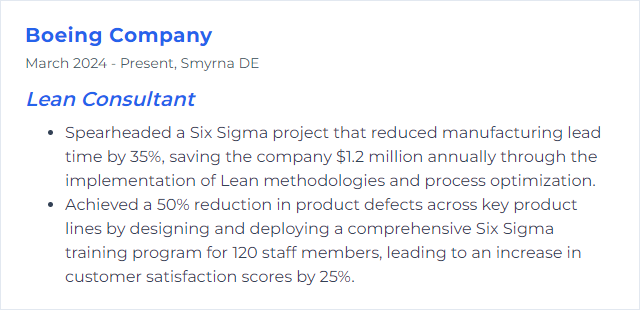
2. Kaizen
Kaizen means continuous improvement—small, steady, relentless. Everyone participates. Processes get lighter and faster over time.
Why It's Important
It turns improvement into a habit, not an event. Waste shrinks, morale rises, performance compounds.
How to Improve Kaizen Skills
- Engage leaders: Model the mindset. Remove hurdles. Celebrate wins loudly and quickly.
- Empower teams: Train people to spot waste, experiment safely, and implement ideas fast.
- Use a crisp cadence: Short cycles, visible goals, simple metrics. Momentum beats perfection.
- Teach visual thinking: Obvious problems get solved first—make issues visible to all.
- Standardize what works: Lock in improvements, then raise the bar again.
- Close the loop: Feedback, reflection, iteration—repeat until the new way becomes the only way.
How to Display Kaizen Skills on Your Resume

3. Value Stream Mapping
Value Stream Mapping (VSM) visualizes how value flows from request to delivery. You see waits, rework, handoffs, and friction. Then you redesign the flow.
Why It's Important
It exposes waste you can’t spot from spreadsheets alone. When the whole system is visible, the right fixes jump out.
How to Improve Value Stream Mapping Skills
- Scope smart: Map a single product family or service line to keep analysis focused.
- Collect real data: Cycle times, wait times, inventory, distance—facts beat assumptions.
- Co-create with cross-functional teams: Different eyes, fuller truth.
- Call out the eight wastes: Label them plainly; prioritize by impact.
- Design the future state: Pull systems, leveled work, right-sized batches, and simpler paths.
- Sequence an implementation plan: Owners, milestones, and KPIs—visible and time-bound.
- Review often: Update maps as processes evolve; keep the picture honest.
How to Display Value Stream Mapping Skills on Your Resume

4. 5S
5S is disciplined workplace organization: Sort, Set in order, Shine, Standardize, Sustain. Clear spaces, clear minds, clean flow.
Why It's Important
It removes clutter, errors, and hesitation. Safety improves. Speed follows.
How to Improve 5S Skills
- Run focused events: Tackle one area at a time; finish strong before moving on.
- Make it visual: Shadow boards, color codes, floor markings—what’s right should be obvious.
- Standardize: Checklists, photos, and concise SOPs keep the baseline stable.
- Audit routinely: Short, frequent audits with clear scores and owners.
- Build habits: Micro-routines at shift start/end. Sustain beats start.
- Recognize teams: Highlight improvements; pride fuels consistency.
How to Display 5S Skills on Your Resume
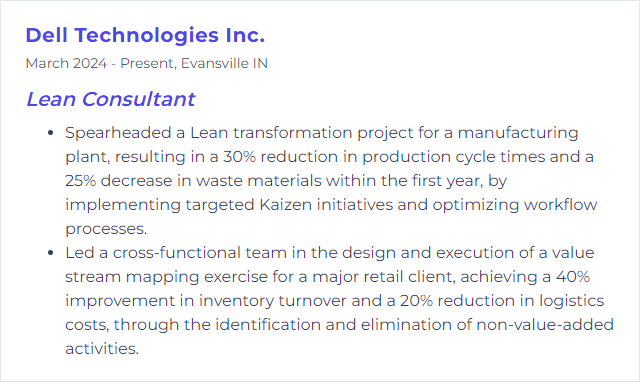
5. Kanban
Kanban is a visual method to manage work as it flows. You limit work in progress, expose bottlenecks, and smooth delivery.
Why It's Important
It aligns capacity with demand and reveals friction in real time. Less juggling, more finishing.
How to Improve Kanban Skills
- Clarify the workflow: Columns that reflect reality, not wishful thinking.
- Set WIP limits: Protect focus; force prioritization.
- Define policies: Entry/exit rules for each column to reduce ambiguity.
- Measure flow: Cycle time, throughput, and aging WIP tell you where to act.
- Run feedback loops: Daily standups and regular retros keep learning alive.
- Experiment: Adjust limits, columns, and classes of service—then watch the data.
How to Display Kanban Skills on Your Resume
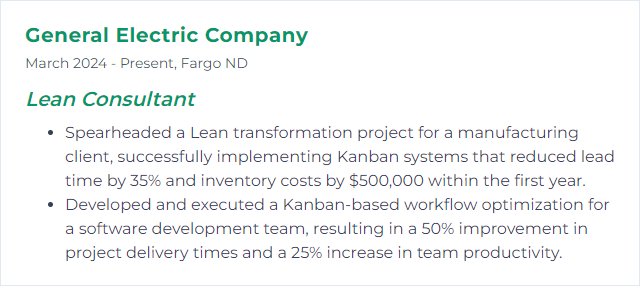
6. JIT (Just-In-Time)
JIT produces exactly what’s needed, when it’s needed, in the quantity needed. Inventory drops. Responsiveness rises.
Why It's Important
It cuts carrying costs and shortens lead times while improving flow to the customer. Cleaner operations, tighter cash.
How to Improve JIT (Just-In-Time) Skills
- Strengthen the supply base: Shared schedules, smaller deliveries, stable quality.
- Pull, don’t push: Trigger production from real demand signals, not forecasts alone.
- Right-size inventory: Use segmentation and safety stock logic that reflects variability.
- Quality at the source: Prevent defects rather than inspect them out.
- Cross-train: Flexible teams absorb variation without chaos.
- Synchronize planning: APS and simple visual signals together—fast and transparent.
How to Display JIT (Just-In-Time) Skills on Your Resume

7. SMED (Single-Minute Exchange of Die)
SMED slashes changeover times—often to single digits of minutes. Less downtime means smaller batches and faster response.
Why It's Important
Quick setups unlock flow. Production becomes flexible, cost-effective, and closer to true demand.
How to Improve SMED (Single-Minute Exchange of Die) Skills
- Study the current changeover: Video, time studies, and detailed step lists reveal waste.
- Split internal vs. external work: Do more prep while the machine runs.
- Convert internal to external: Pre-set tools, quick-release clamps, kits ready to go.
- Standardize tools and motions: Everything in its place, minimal adjustments.
- Parallelize tasks: Two people, synchronized steps—seconds matter.
- Simplify the rest: Fewer fasteners, guides, and mistake-proofing where feasible.
- Train and audit: Keep the gains; revisit regularly for another cut.
How to Display SMED (Single-Minute Exchange of Die) Skills on Your Resume
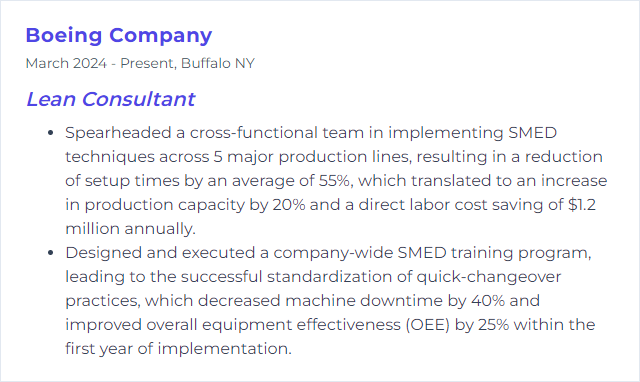
8. PDCA (Plan-Do-Check-Act)
PDCA is the engine of continuous improvement. Plan deliberately, try quickly, check honestly, act decisively—then loop.
Why It's Important
It brings rigor without red tape. Problems shrink because learning cycles speed up.
How to Improve PDCA (Plan-Do-Check-Act) Skills
- Plan: Define the problem clearly; align on metrics; use root cause tools so you fix causes, not symptoms.
- Do: Pilot small; keep risk low and feedback high.
- Check: Compare results to targets using real-time indicators and visual management.
- Act: Standardize what worked, adjust what didn’t, and spin the next cycle with sharper focus.
How to Display PDCA (Plan-Do-Check-Act) Skills on Your Resume
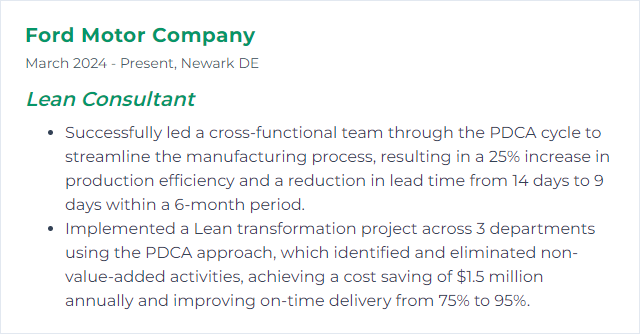
9. TPM (Total Productive Maintenance)
TPM maximizes equipment effectiveness by engaging everyone—operators, maintenance, leaders. Proactive, preventive, and proud.
Why It's Important
Breakdowns plunge, quality stabilizes, throughput climbs. Uptime becomes a habit, not a hope.
How to Improve TPM (Total Productive Maintenance) Skills
- Teach the basics: Common language, clear goals, and everyday checks.
- Autonomous maintenance: Operators clean, inspect, and detect early—ownership at the source.
- Planned and predictive work: Use history and condition data to prevent surprises.
- Focused improvement: Cross-functional teams attack chronic losses with data and discipline.
- Design for maintainability: Easier access, faster changeovers, better indications.
- Safety first: Build safety and environmental checks into every activity.
- Review relentlessly: OEE trends, loss trees, and action logs guide the next move.
How to Display TPM (Total Productive Maintenance) Skills on Your Resume
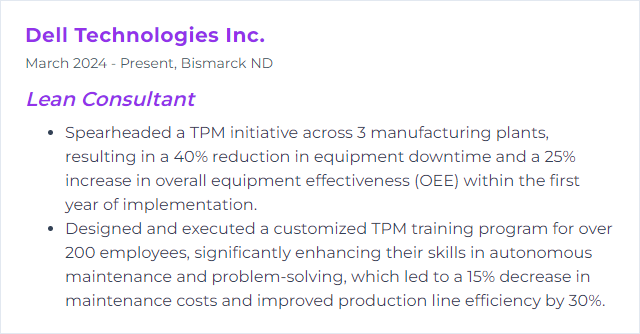
10. A3 Problem Solving
A3 is a structured, one-page method to tell the whole story—context, current state, root causes, targets, countermeasures, and follow-up. Clear, visual, aligned.
Why It's Important
It forces disciplined thinking and shared understanding. Better decisions, faster execution.
How to Improve A3 Problem Solving Skills
- Craft a sharp problem statement: Specific, measurable, time-bound—no vagueness.
- Ground it in facts: Go see, gather data, and map the process.
- Find root causes: Use 5 Whys and cause-and-effect diagrams to go beneath the surface.
- Set a target condition: Define success so everyone rows the same direction.
- Pick practical countermeasures: High impact, feasible, owned by the right people.
- Implement visibly: Who, what, when—tracked openly.
- Follow up: Verify results, prevent backslide, and capture lessons learned.
How to Display A3 Problem Solving Skills on Your Resume

11. Root Cause Analysis
Root Cause Analysis (RCA) is the disciplined hunt for the real reason behind a problem. Fix the cause, not the symptom, and the issue stays gone.
Why It's Important
Without RCA, you’re swatting flies. With it, you’re closing windows.
How to Improve Root Cause Analysis Skills
- Define the problem well: Scope tightly; avoid loaded language.
- Use multiple tools: 5 Whys, fishbone diagrams, Pareto charts—triangulate the truth.
- Map the process: Reality beats assumption every time.
- Engage those closest to the work: Frontline insights shorten the search.
- Test causes: Seek evidence; run small experiments to confirm.
- Implement and monitor: Track outcomes and watch for unintended effects.
- Standardize and share: Document the fix and spread the learning.
How to Display Root Cause Analysis Skills on Your Resume
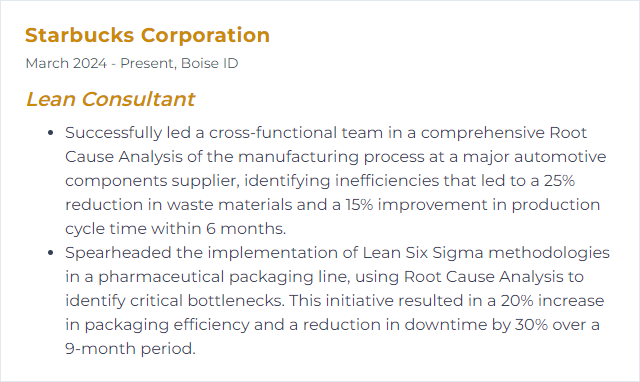
12. Gemba Walk
A Gemba Walk takes you to the place where the work happens. You observe the process, talk with people, and spot opportunities in the real world, not the meeting room.
Why It's Important
Reality checks assumptions. You see flow, friction, and fixes in context.
How to Improve Gemba Walk Skills
- Prepare a purpose: Define what you’re looking to learn; inform teams so it’s collaborative, not punitive.
- Observe the process: Follow value through steps; watch handoffs, waits, and workarounds.
- Ask open questions: Seek understanding; invite ideas.
- Show respect: Listen deeply, credit insights, and remove obstacles.
- Document and act: Capture findings, assign owners, and close the loop visibly.
- Repeat regularly: Make walks a habit; improvements accelerate when leaders show up.
How to Display Gemba Walk Skills on Your Resume

